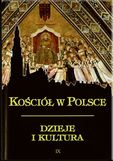ORGANIZACJA KOŚCIOŁA W STAROŻYTNOŚCI I ŚREDNIOWIECZU. TEORIA I PRAKTYKA
The organization of the Church in antiquity and the Middle Ages.
Author(s): Włodzimierz BielakSubject(s): History
Published by: Katolicki Uniwersytet Lubelski Jana Pawła II - Wydział Teologii
Keywords: Church organization; Middle Ages; Antiquity; parishes; dioceses
Summary/Abstract: The article is dedicated to the development of church organization in antiquity and the Middle Ages. In particular, we are interested in the historical relationship between theoretical theological considerations about the nature and development of ecclesiastical institutions and the practical circumstances in which this development occurred. The theory did not always match the practice. The best example is the office of a bishop. In theory, a bishop had always been primarily a pastor and father of his local Church. He performed these functions and he was perceived that way in the first three centuries of Christianity. The situation changed in the Middle Ages, although these changes had already been initiated in the fourth century by Constantine the Great, who made Christianity the state religion. The inclusion of the Church in the structure of the Roman Empire made bishops, in a sense, public officials. This resulted in emphasizing the legal and jurisdictional importance of bishopric. The bishops became administrators of their dioceses and representatives of the Church in dealings with the rulers, who in turn sought to subordinate the Church. This relationship between the throne and the altar, which was characteristic of the whole Middle Ages, contributed to the fact that bishops were strongly involved in social and political life of countries, that is why in practice bishops were statesmen and the rulers of their dioceses. In antiquity, there was a close relationship between the bishop and his local Church. Ancient councils forbade bishops to transfer from one diocese to another. In the Middle Ages no one remembered about it, and taking over a new, more prestigious diocese was a simple way of ecclesiastical career. The further part of this article concentrates on the formation of the ecclesiastical institutions: dioceses, metropolises, patriarchates. It emphasizes the fact that the Church derived the patterns of its organization from the Roman Empire. The article also mentions the differences between the organization of Eastern and Western Churches at the level of lower order institutions: parishes and archidiaconates.
Journal: Kościół w Polsce. Dzieje i kultura
- Issue Year: 2013
- Issue No: 12
- Page Range: 23-39
- Page Count: 17
- Language: Polish

